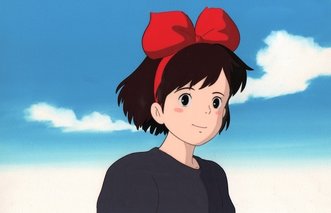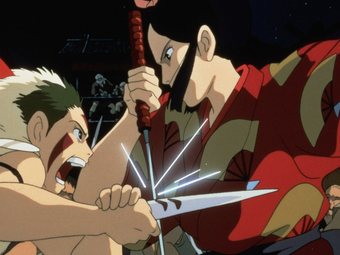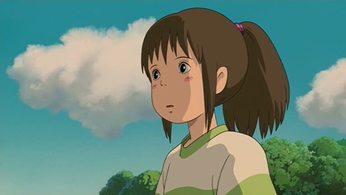Written by Kate McHargueI could do an in depth analysis of every Miyazaki heroine and how crazy feminist and awesome they are (and I probably will one day) but for now I’m just gonna go over a few of my favorites and outline the basics of each one’s bad-assery. Kiki - Kiki’s Delivery Service Kiki is an excitable young witch (literally) who is leaving home to explore the world and find a town in need of a good witch. A bit naive but full of curiosity and enthusiasm, she quickly finds a city she likes the look of. Ever the independent young woman, Kiki finds a job at a local bakery which she transforms into her very own delivery service. Let’s put that in perspective for a moment, Kiki is a small business owner living on her own in a strange city...at the age of 13. While other animated teenage characters are focused on love troubles, Kiki is more focused on finding her place in the world and helping others. And yes, she does get a sort of love interest in Tombo but rather than a typical 'boy meets girl' love story we get a 'girl saves boy from certain death by believing in herself' story. When Kiki struggles to make it in the big city she has a crisis of faith and begins to lose her witch talents. She starts to doubt herself and her abilities, fearing that the world may be too much for her handle. It is her friend Osono, another independent young woman who does things a little differently, that helps her find her way again. Kiki shows us that young women have so much potential to do good and affect real change in the world. We just need to encourage them and give them the space to soar. Sophie - Howl’s Moving Castle Sophie is introduced as the quiet, mild mannered daughter of a hat maker. In the first 10 minutes of the film she is harassed by two soldiers who call her a 'little mouse' and claim she’s 'cuter when she’s scared.' With the appearance of the Wizard Howl, it becomes clear that Sophie isn’t afraid (people who are fearful don’t typically waltz through the sky with a wizard who is rumored to eat hearts). She’s just unsure of herself and struggling to find her voice, like a lot of young women. When she is cursed by the Witch of the Waste and begins her adventure, she does so without complaint or fear. She simply pulls herself together and heads out into the world to find a place for herself. Along the way, she finds that she actually has a lot to say and won’t let anyone stop her from saying it. She verbally spars with a literal fire demon and puts an all powerful wizard in his place when he throws a temper tantrum. The film points to the idea that her initial timidness came from a belief that she was not beautiful, at least not like other girls, and therefore her words and desires had little worth. Howl does his best to lift the curse and tells Sophie that she is, indeed, beautiful. But the curse is not lifted until Sophie comes accept this herself, proving that what gave the curse power was her own uncertainty and self-doubt. Her journey is one of pure self-discovery and self-acceptance as the hero of her own story. She learns that her power comes from within and that no one can take it from her. San and Lady Eboshi - Princess Mononoke Raised by wolves in an ancient forest, San is the furthest thing from your typical princess. She wears furs, fights battles, and is often seen dripping in blood. Upon meeting the protagonist, Ashitaka, she immediately tries to kill him. And why does she try and kill him? Because he stopped her from killing Lady Eboshi. And why did she want to kill Lady Eboshi? Because she’s an industrial tycoon that provides gainful employment to individuals with leprosy and relies on the women of her town to make the iron necessary to drive her war machine. Both San and Lady Eboshi are strong willed and fearless, charging into battle with a single intent…to kill the other and protect what’s theirs. While the film follows Ashitaka’s journey to find a cure after he is attacked by a demon from San’s forest, San and Lady Eboshi are arguably the most complex and interesting characters. San hates humans, despite being one, and fights against the wanton violence and disregard for nature that they have brought to the forest. Lady Eboshi’s only concern is to create a safe and prosperous town for her people and her tunnel vision in achieving this goal is the reason the forest is put in jeopardy. Both women are violent, passionate, and leaders in their communities. What’s more? No one ever questions their authority or doubts their abilities. In other words, they are respected and portrayed as complex individuals. It’s almost like we could learn something from that... Chihiro - Spirited Away Chihiro is unlikable at first and that alone makes her a feminist icon. Many portrayals of young female protagonists, animated or otherwise, promote the ideals of innocence, selflessness, and kindness to the point of sainthood. In other words, they are extremely likeable because they apparently have no flaws and no room to truly grow. Chihiro is whiny, selfish, and ungrateful and it is refreshingly realistic to see a young girl be allowed to be these things. While on her adventure Chihiro does learn the value of hard work, sacrifice, and humility, but she is allowed to grow naturally through her experiences. She is not shamed for those qualities that are 'unlikeable' because everyone is a little unlikeable to a certain extent and young women are no exception. And while the aforementioned 'likeable' female protagonist archetype is usually given a love story as her only means for growth, Chihiro is instead given profound friendships that teach her about the kind of person she wants to be. As with the other Miyazaki heroines, Chihiro is the hero of her own story. She saves her friend Mako from the brink of death. She saves her parents from becoming Yubaba’s dinner. She saves herself from slavery and wins freedom for herself and those she loves. She has a support system but ultimately it is her own intuition and will to survive that saves the day. She may not always be likeable but it seems Miyazaki believes that young women have more to offer the world than just being well liked. I may have chosen some of the more well known films to analyze but the truth is that all of Miyazaki’s films provide female characters that portray the myriad different 'types' of women. Each of his heroines are unique and goes on their own journey of self-discovery and heroism. They have friends and loved ones to support them and guide them along the way, but ultimately the lesson is that they must decide for themselves. They are given agency to make mistakes, be unlikeable, to falter and lose faith. They are allowed to be unapologetically themselves and are even celebrated for it. I love a good princess film and there’s nothing wrong with a sappy love story, but growing up and watching Miyazaki’s films showed me that women could do and be more and that there is no right or wrong way to be yourself. All of his films may have an element of the fantastical but for me Miyazaki’s films affirm the idea that art imitates life. I see his heroines in my own friends and loved ones, the women in my life who are complicated and passionate and sometimes unsure of themselves. These heroines show us that there is power in self-acceptance and in defying anyone who would tell you differently. And while I’ve placed a lot of importance on the positive representation these characters provide to young women, I think these heroines can teach everyone a little something about what it means to be a hero.
0 Comments
Leave a Reply. |
Archives
March 2025
|
|
© 2012-2025, Nerds That Geek LLC.
All Rights Reserved. |
uWeb Hosting by FatCow


 RSS Feed
RSS Feed